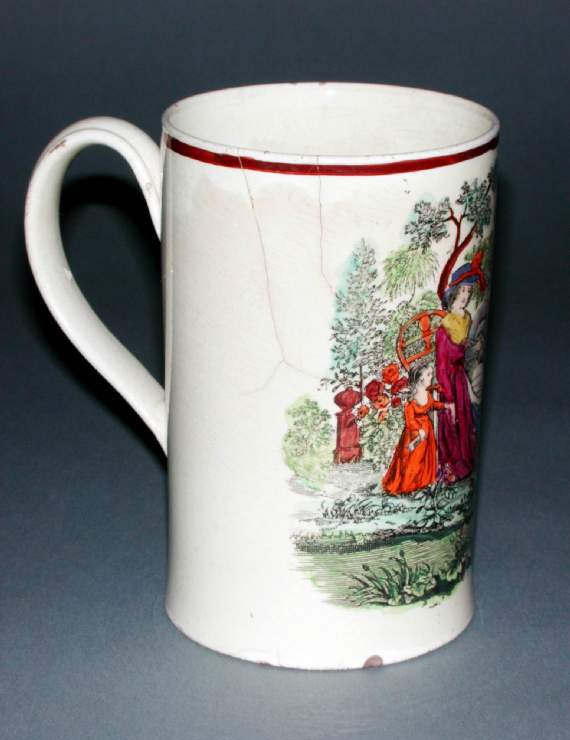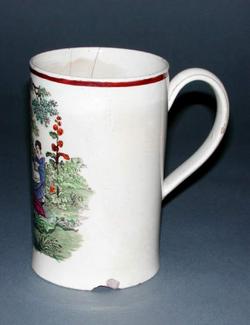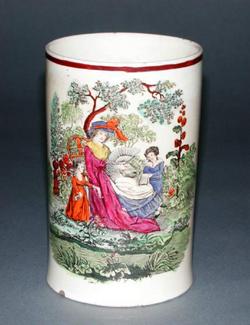Current Location: In storage
Maker(s)
Production:
unidentified English pottery
Entities
Categories
Description
Lead-glazed creamware decorated with a transfer print of a woman and two children, which has been coloured in enamels.
Cream-coloured earthenware, lead-glazed, transfer printed onglaze in black and painted onglaze with coloured enamels. The cylindrical mug has a loop handle. Opposite the handle is a print of a woman holding a fan and wearing a hat decorated with a feather. She sits in a chair with a small child on either side. The group sit under a tree and bushes and flowers surround them. The central woman’s dress is coloured purple and her hat blue. One of the children wears an orange dress and the other a blue one. The plants are painted in orange, green, pale blue and red-brown. There is a red-brown ring around the rim of the mug.
Notes
History note: Provenance unidentified before bought in Saffron Walden by Mr Freeman, Cambridge; Mr Freeman sold for 10/- in March 1905 to Dr J.W.L. Glaisher, FRS, Trinity College, Cambridge
Legal notes
Dr J.W.L. Glaisher Bequest.
Measurements and weight
Height: 12.3 cm
Width: 11.7 cm
Acquisition and important dates
Method of acquisition: Bequeathed
(1928-12-07)
by
Glaisher, J. W. L., Dr
Dating
18th Century, Late
George III
Circa
1775
CE
-
Circa
1790
CE
Note
Transfer printing was introduced to English pottery in the second half of the 18th century. Most early transfer-printed ware used the glue bat method. In this method, the design was engraved on a copper plate, which was then covered with linseed oil. The thin bat of animal glue was pressed onto the oiled plate and then applied to the ware. Once the bat was removed, the ware was dusted with powdered metallic oxide, which adhered to the oil, and fired to fix the design. This method was common for round-bodied vessels like this mug because the flexible glue bat can easily stretch round curving body. Objects, like this mug, that were printed and then painted in enamels were more expensive to consumers they plain printed wares, reflecting the cost of the extra firing necessary to bond the enamels onto the surface.
School or Style
Rococo
Components of the work
Body
Materials used in production
clear
Lead-glaze
cream coloured
Earthenware
Enamels
Techniques used in production
Painting overglaze
Transfer printing
Lead-glazing
Inscription or legends present
Inscription present: rectangle of brown card
- Text: “Mug, printed in black and painted over in enamel colours. Staffordshire, about 1790. 739. Glaisher Bequest 1928.”
- Location: Loose inside the mug
- Method of creation: Handwritten in black ink
- Type: Label
References and bibliographic entries
Identification numbers
Accession number: C.739-1928
Primary reference Number: 75954
Old catalogue number: 2250
Stable URI
Audit data
Created: Saturday 6 August 2011
Updated: Monday 29 April 2024
Last processed: Tuesday 15 July 2025
Associated departments & institutions
Owner or interested party:
The Fitzwilliam Museum
Associated department:
Applied Arts






